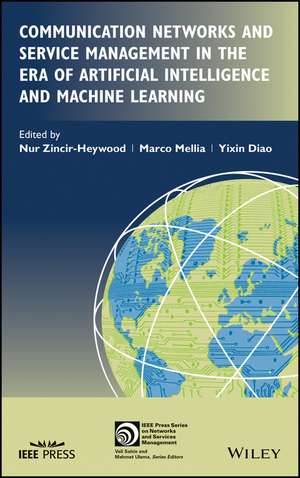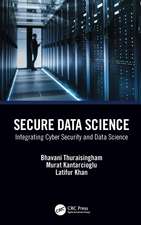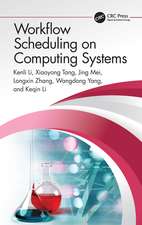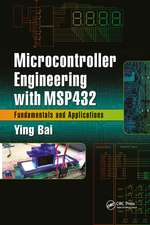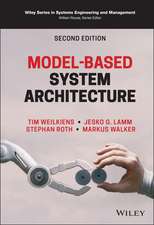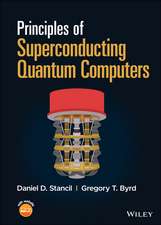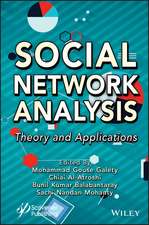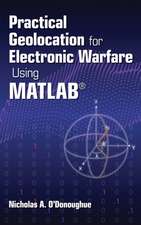Communication Networks and Service Management in the Era of Artificial Intelligence and Machine Learning: IEEE Press Series on Networks and Service Management
Autor N Zincir–Heywooden Limba Engleză Hardback – 20 oct 2021
Communication Networks and Service Management in the Era of Artificial Intelligence and Machine Learning delivers a comprehensive overview of the impact of artificial intelligence (AI) and machine learning (ML) on service and network management. Beginning with a fulsome description of ML and AI, the book moves on to discuss management models, architectures, and frameworks. The authors also explore how AI and ML can be used in service management functions like the generation of workload profiles, service provisioning, and more.
The book includes a handpicked selection of applications and case studies, as well as a treatment of emerging technologies the authors predict could have a significant impact on network and service management in the future. Statistical analysis and data mining are also discussed, particularly with respect to how they allow for an improvement of the management and security of IT systems and networks. Readers will also enjoy topics like:
- A thorough introduction to network and service management, machine learning, and artificial intelligence
- An exploration of artificial intelligence and machine learning for management models, including autonomic management, policy-based management, intent based -management, and network virtualization-based management
- Discussions of AI and ML for architectures and frameworks, including cloud -systems, software defined networks, 5G and 6G networks, and Edge/Fog networks
- An examination of AI and ML for service management, including the automatic -generation of workload profiles using unsupervised learning
Din seria IEEE Press Series on Networks and Service Management
- 9%
 Preț: 1032.08 lei
Preț: 1032.08 lei - 9%
 Preț: 1267.23 lei
Preț: 1267.23 lei -
 Preț: 412.52 lei
Preț: 412.52 lei - 9%
 Preț: 835.71 lei
Preț: 835.71 lei - 9%
 Preț: 799.94 lei
Preț: 799.94 lei - 9%
 Preț: 834.67 lei
Preț: 834.67 lei - 20%
 Preț: 474.27 lei
Preț: 474.27 lei - 9%
 Preț: 871.70 lei
Preț: 871.70 lei - 9%
 Preț: 783.69 lei
Preț: 783.69 lei - 9%
 Preț: 726.66 lei
Preț: 726.66 lei - 9%
 Preț: 795.63 lei
Preț: 795.63 lei - 8%
 Preț: 644.16 lei
Preț: 644.16 lei - 9%
 Preț: 698.48 lei
Preț: 698.48 lei - 32%
 Preț: 602.05 lei
Preț: 602.05 lei - 32%
 Preț: 524.44 lei
Preț: 524.44 lei
Preț: 815.79 lei
Preț vechi: 896.47 lei
-9% Nou
Puncte Express: 1224
Preț estimativ în valută:
156.12€ • 169.52$ • 131.14£
156.12€ • 169.52$ • 131.14£
Carte tipărită la comandă
Livrare economică 22 aprilie-06 mai
Preluare comenzi: 021 569.72.76
Specificații
ISBN-13: 9781119675501
ISBN-10: 1119675502
Pagini: 400
Dimensiuni: 159 x 236 x 27 mm
Greutate: 0.7 kg
Editura: Wiley
Seria IEEE Press Series on Networks and Service Management
Locul publicării:Hoboken, United States
ISBN-10: 1119675502
Pagini: 400
Dimensiuni: 159 x 236 x 27 mm
Greutate: 0.7 kg
Editura: Wiley
Seria IEEE Press Series on Networks and Service Management
Locul publicării:Hoboken, United States
Notă biografică
Nur Zincir-Heywood, PhD, is Full Professor of Computer Science with Dalhousie University in Nova Scotia, Canada. She is an Associate Editor of the IEEE Transactions on Network and Service Management and Wiley International Journal of Network Management. Marco Mellia, PhD, is Full Professor with Politecnico di Torino, Italy. He is an Associate Editor of the IEEE Transactions on Network and Service Management, Elsevier Computer Networks and ACM Computer Communication Reviews. Yixin Diao, PhD, is Director of Data Science and Analytics at PebblePost in New York, NY, USA. He is an Associate Editor of the IEEE Transactions on Network and Service Management and the Journal of Network and Systems Management.
Cuprins
List of Contributors xv
Preface xxi
Acknowledgments xxv
Acronyms xxvii
Part I Introduction 1
1 Overview of Network and Service Management 3
Marco Mellia, Nur Zincir-Heywood, and Yixin Diao
1.1 Network and Service Management at Large 3
1.2 Data Collection and Monitoring Protocols 5
1.2.1 SNMP Protocol Family 5
1.2.2 Syslog Protocol 5
1.2.3 IP Flow Information eXport (IPFIX) 6
1.2.4 IP Performance Metrics (IPPM) 7
1.2.5 Routing Protocols and Monitoring Platforms 8
1.3 Network Configuration Protocol 9
1.3.1 Standard Configuration Protocols and Approaches 9
1.3.2 Proprietary Configuration Protocols 10
1.3.3 Integrated Platforms for Network Monitoring 10
1.4 Novel Solutions and Scenarios 12
1.4.1 Software-Defined Networking - SDN 12
1.4.2 Network Functions Virtualization -NFV 14
Bibliography 15
2 Overview of Artificial Intelligence and Machine Learning 19
Nur Zincir-Heywood, Marco Mellia, and Yixin Diao
2.1 Overview 19
2.2 Learning Algorithms 20
2.2.1 Supervised Learning 21
2.2.2 Unsupervised Learning 22
2.2.3 Reinforcement Learning 23
2.3 Learning for Network and Service Management 24
Bibliography 26
Part II Management Models and Frameworks 33
3 Managing Virtualized Networks and Services with Machine Learning 35
Raouf Boutaba, Nashid Shahriar, Mohammad A. Salahuddin, and Noura Limam
3.1 Introduction 35
3.2 Technology Overview 37
3.2.1 Virtualization of Network Functions 38
3.2.1.1 Resource Partitioning 38
3.2.1.2 Virtualized Network Functions 40
3.2.2 Link Virtualization 41
3.2.2.1 Physical Layer Partitioning 41
3.2.2.2 Virtualization at Higher Layers 42
3.2.3 Network Virtualization 42
3.2.4 Network Slicing 43
3.2.5 Management and Orchestration 44
3.3 State-of-the-Art 46
3.3.1 Network Virtualization 46
3.3.2 Network Functions Virtualization 49
3.3.2.1 Placement 49
3.3.2.2 Scaling 52
3.3.3 Network Slicing 55
3.3.3.1 Admission Control 55
3.3.3.2 Resource Allocation 56
3.4 Conclusion and Future Direction 59
3.4.1 Intelligent Monitoring 60
3.4.2 Seamless Operation and Maintenance 60
3.4.3 Dynamic Slice Orchestration 61
3.4.4 Automated Failure Management 61
3.4.5 Adaptation and Consolidation of Resources 61
3.4.6 Sensitivity to Heterogeneous Hardware 62
3.4.7 Securing Machine Learning 62
Bibliography 63
4 Self-Managed 5G Networks 69
Jorge Martín-Pérez, Lina Magoula, Kiril Antevski, Carlos Guimarães, Jorge Baranda, Carla Fabiana Chiasserini, Andrea Sgambelluri, Chrysa Papagianni, Andrés García-Saavedra, Ricardo Martínez, Francesco Paolucci, Sokratis Barmpounakis, Luca Valcarenghi, Claudio EttoreCasetti, Xi Li, Carlos J. Bernardos, Danny De Vleeschauwer, Koen De Schepper, Panagiotis Kontopoulos, Nikolaos Koursioumpas, Corrado Puligheddu, Josep Mangues-Bafalluy, and Engin Zeydan
4.1 Introduction 69
4.2 Technology Overview 73
4.2.1 RAN Virtualization and Management 73
4.2.2 Network Function Virtualization 75
4.2.3 Data Plane Programmability 76
4.2.4 Programmable Optical Switches 77
4.2.5 Network Data Management 78
4.3 5G Management State-of-the-Art 80
4.3.1 RAN resource management 80
4.3.1.1 Context-Based Clustering and Profiling for User and Network Devices 80
4.3.1.2 Q-Learning Based RAN Resource Allocation 81
4.3.1.3 vrAIn: AI-Assisted Resource Orchestration for Virtualized Radio Access Networks 81
4.3.2 Service Orchestration 83
4.3.3 Data Plane Slicing and Programmable Traffic Management 85
4.3.4 Wavelength Allocation 86
4.3.5 Federation 88
4.4 Conclusions and Future Directions 89
Bibliography 92
5 AI in 5G Networks: Challenges and Use Cases 101
Stanislav Lange, Susanna Schwarzmann, Marija Gaji¿c, Thomas Zinner, and Frank A. Kraemer
5.1 Introduction 101
5.2 Background 103
5.2.1 ML in the Networking Context 103
5.2.2 ML in Virtualized Networks 104
5.2.3 ML for QoE Assessment and Management 104
5.3 Case Studies 105
5.3.1 QoE Estimation and Management 106
5.3.1.1 Main Challenges 107
5.3.1.2 Methodology 108
5.3.1.3 Results and Guidelines 109
5.3.2 Proactive VNF Deployment 110
5.3.2.1 Problem Statement and Main Challenges 111
5.3.2.2 Methodology 112
5.3.2.3 Evaluation Results and Guidelines 113
5.3.3 Multi-service, Multi-domain Interconnect 115
5.4 Conclusions and Future Directions 117
Bibliography 118
6 Machine Learning for Resource Allocation in Mobile Broadband Networks 123
Sadeq B. Melhem, Arjun Kaushik, Hina Tabassum, and Uyen T. Nguyen
6.1 Introduction 123
6.2 ML in Wireless Networks 124
6.2.1 Supervised ML 124
6.2.1.1 Classification Techniques 125
6.2.1.2 Regression Techniques 125
6.2.2 Unsupervised ML 126
6.2.2.1 Clustering Techniques 126
6.2.2.2 Soft Clustering Techniques 127
6.2.3 Reinforcement Learning 127
6.2.4 Deep Learning 128
6.2.5 Summary 129
6.3 ML-Enabled Resource Allocation 129
6.3.1 Power Control 131
6.3.1.1 Overview 131
6.3.1.2 State-of-the-Art 131
6.3.1.3 Lessons Learnt 132
6.3.2 Scheduling 132
6.3.2.1 Overview 132
6.3.2.2 State-of-the-Art 132
6.3.2.3 Lessons Learnt 134
6.3.3 User Association 134
6.3.3.1 Overview 134
6.3.3.2 State-of-the-Art 136
6.3.3.3 Lessons Learnt 136
6.3.4 Spectrum Allocation 136
6.3.4.1 Overview 136
6.3.4.2 State-of-the-Art 138
6.3.4.3 Lessons Learnt 138
6.4 Conclusion and Future Directions 140
6.4.1 Transfer Learning 140
6.4.2 Imitation Learning 140
6.4.3 Federated-Edge Learning 141
6.4.4 Quantum Machine Learning 142
Bibliography 142
7 Reinforcement Learning for Service Function Chain Allocation in Fog Computing 147
José Santos, Tim Wauters, Bruno Volckaert, and Filip De Turck
7.1 Introduction 147
7.2 Technology Overview 148
7.2.1 Fog Computing (FC) 149
7.2.2 Resource Provisioning 149
7.2.3 Service Function Chaining (SFC) 150
7.2.4 Micro-service Architecture 150
7.2.5 Reinforcement Learning (RL) 151
7.3 State-of-the-Art 152
7.3.1 Resource Allocation for Fog Computing 152
7.3.2 ML Techniques for Resource Allocation 153
7.3.3 RL Methods for Resource Allocation 154
7.4 A RL Approach for SFC Allocation in Fog Computing 155
7.4.1 Problem Formulation 155
7.4.2 Observation Space 156
7.4.3 Action Space 157
7.4.4 Reward Function 158
7.4.5 Agent 161
7.5 Evaluation Setup 162
7.5.1 Fog-Cloud Infrastructure 162
7.5.2 Environment Implementation 162
7.5.3 Environment Configuration 164
7.6 Results 165
7.6.1 Static Scenario 165
7.6.2 Dynamic Scenario 167
7.7 Conclusion and Future Direction 169
Bibliography 170
Part III Management Functions and Applications 175
8 Designing Algorithms for Data-Driven Network Management and Control: State-of-the-Art and Challenges 177
Andreas Blenk, Patrick Kalmbach, Johannes Zerwas, and Stefan Schmid
8.1 Introduction 177
8.1.1 Contributions 179
8.1.2 Exemplary Network Use Case Study 179
8.2 Technology Overview 181
8.2.1 Data-Driven Network Optimization 181
8.2.2 Optimization Problems over Graphs 182
8.2.3 From Graphs to ML/AI Input 184
8.2.4 End-to-End Learning 187
8.3 Data-Driven Algorithm Design: State-of-the Art 188
8.3.1 Data-Driven Optimization in General 188
8.3.2 Data-Driven Network Optimization 190
8.3.3 Non-graph Related Problems 192
8.4 Future Direction 193
8.4.1 Data Production and Collection 193
8.4.2 ML and AI Advanced Algorithms for Network Management with Performance Guarantees 194
8.5 Summary 194
Acknowledgments 195
Bibliography 195
9 AI-Driven Performance Management in Data-Intensive Applications 199
Ahmad Alnafessah, Gabriele Russo Russo, Valeria Cardellini, Giuliano Casale, and Francesco Lo Presti
9.1 Introduction 199
9.2 Data-Processing Frameworks 200
9.2.1 Apache Storm 200
9.2.2 Hadoop MapReduce 201
9.2.3 Apache Spark 202
9.2.4 Apache Flink 202
9.3 State-of-the-Art 203
9.3.1 Optimal Configuration 203
9.3.1.1 Traditional Approaches 203
9.3.1.2 AI Approaches 204
9.3.1.3 Example: AI-Based Optimal Configuration 206
9.3.2 Performance Anomaly Detection 207
9.3.2.1 Traditional Approaches 208
9.3.2.2 AI Approaches 208
9.3.2.3 Example: ANNs-Based Anomaly Detection 210
9.3.3 Load Prediction 211
9.3.3.1 Traditional Approaches 212
9.3.3.2 AI Approaches 212
9.3.4 Scaling Techniques 213
9.3.4.1 Traditional Approaches 213
9.3.4.2 AI Approaches 214
9.3.5 Example: RL-Based Auto-scaling Policies 214
9.4 Conclusion and Future Direction 216
Bibliography 217
10 Datacenter Traffic Optimization with Deep Reinforcement Learning 223
Li Chen, Justinas Lingys, Kai Chen, and Xudong Liao
10.1 Introduction 223
10.2 Technology Overview 225
10.2.1 Deep Reinforcement Learning (DRL) 226
10.2.2 Applying ML to Networks 227
10.2.3 Traffic Optimization Approaches in Datacenter 229
10.2.4 Example: DRL for Flow Scheduling 230
10.2.4.1 Flow Scheduling Problem 230
10.2.4.2 DRL Formulation 230
10.2.4.3 DRL Algorithm 231
10.3 State-of-the-Art: AuTO Design 231
10.3.1 Problem Identified 231
10.3.2 Overview 232
10.3.3 Peripheral System 233
10.3.3.1 Enforcement Module 233
10.3.3.2 Monitoring Module 234
10.3.4 Central System 234
10.3.5 DRL Formulations and Solutions 235
10.3.5.1 Optimizing MLFQ Thresholds 235
10.3.5.2 Optimizing Long Flows 239
10.4 Implementation 239
10.4.1 Peripheral System 239
10.4.1.1 Monitoring Module (MM): 240
10.4.1.2 Enforcement Module (EM): 240
10.4.2 Central System 241
10.4.2.1 sRLA 241
10.4.2.2 lRLA 242
10.5 Experimental Results 242
10.5.1 Setting 243
10.5.2 Comparison Targets 244
10.5.3 Experiments 244
10.5.3.1 Homogeneous Traffic 244
10.5.3.2 Spatially Heterogeneous Traffic 245
10.5.3.3 Temporally and Spatially Heterogeneous Traffic 246
10.5.4 Deep Dive 247
10.5.4.1 Optimizing MLFQ Thresholds using DRL 247
10.5.4.2 Optimizing Long Flows using DRL 248
10.5.4.3 System Overhead 249
10.6 Conclusion and Future Directions 251
Bibliography 253
11 The New Abnormal: Network Anomalies in the AI Era 261
Francesca Soro, Thomas Favale, Danilo Giordano, Luca Vassio, Zied Ben Houidi, and Idilio Drago
11.1 Introduction 261
11.2 Definitions and Classic Approaches 262
11.2.1 Definitions 263
11.2.2 Anomaly Detection: A Taxonomy 263
11.2.3 Problem Characteristics 264
11.2.4 Classic Approaches 266
11.3 AI and Anomaly Detection 267
11.3.1 Methodology 267
11.3.2 Deep Neural Networks 268
11.3.3 Representation Learning 270
11.3.4 Autoencoders 271
11.3.5 Generative Adversarial Networks 272
11.3.6 Reinforcement Learning 274
11.3.7 Summary and Takeaways 275
11.4 Technology Overview 277
11.4.1 Production-Ready Tools 277
11.4.2 Research Alternatives 279
11.4.3 Summary and Takeaways 280
11.5 Conclusions and Future Directions 282
Bibliography 283
12 Automated Orchestration of Security Chains Driven by Process Learning 289
Nicolas Schnepf, Rémi Badonnel, Abdelkader Lahmadi, and Stephan Merz
12.1 Introduction 289
12.2 RelatedWork 290
12.2.1 Chains of Security Functions 291
12.2.2 Formal Verification of Networking Policies 292
12.3 Background 294
12.3.1 Flow-Based Detection of Attacks 294
12.3.2 Programming SDN Controllers 295
12.4 Orchestration of Security Chains 296
12.5 Learning Network Interactions 298
12.6 Synthesizing Security Chains 301
12.7 Verifying Correctness of Chains 306
12.7.1 Packet Routing 306
12.7.2 Shadowing Freedom and Consistency 306
12.8 Optimizing Security Chains 308
12.9 Performance Evaluation 311
12.9.1 Complexity of Security Chains 312
12.9.2 Response Times 313
12.9.3 Accuracy of Security Chains 313
12.9.4 Overhead Incurred by Deploying Security Chains 314
12.10 Conclusions 315
Bibliography 316
13 Architectures for Blockchain-IoT Integration 321
Sina Rafati Niya, Eryk Schiller, and Burkhard Stiller
13.1 Introduction 321
13.1.1 Blockchain Basics 323
13.1.2 Internet-of-Things (IoT) Basics 324
13.2 Blockchain-IoT Integration (BIoT) 325
13.2.1 BIoT Potentials 326
13.2.2 BIoT Use Cases 328
13.2.3 BIoT Challenges 329
13.2.3.1 Scalability 332
13.2.3.2 Security 333
13.2.3.3 Energy Efficiency 334
13.2.3.4 Manageability 335
13.3 BIoT Architectures 335
13.3.1 Cloud, Fog, and Edge-Based Architectures 337
13.3.2 Software-Defined Architectures 337
13.3.3 A Potential Standard BIoT Architecture 338
13.4 Summary and Considerations 341
Bibliography 342
Index 345
